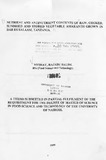| dc.description.abstract | Amaranthus hybridus was grown for leafy vegetables in four sites in Dar es Salaam,
Tanzania. Freshly harvested leaves from each of the growing sites were analyzed for
proximate composition, ascorbic acid. beta-carotene, minerals iron, calcium, phosphorous
and lead; and the antinutrients oxalates and nitrates.
The leaves from the four sites were then bulked. Samples from the bulk were cooked by
boiling in distilled water and drained. The drained vegetables were analyzed for ascorbic
acid. beta-carotene, iron, calcium, phosphorous, lead, oxalate and nitrate. Also samples
from freshly harvested bulks were blanched and sundried in a shade provision drier. The
dried samples were stored in polythene bags at 22°C, 28°C and room temperature (30°C
to 32°C). At the beginning and thereafter every month during storage, the vegetables
were analyzed for beta-carotene and ascorbic acid and dried samples stored at 22°C were
subjected to sensory evaluation in comparison with fresh cooked leaves.
Results indicated that fresh amaranth vegetables from the four sites had comparable high
moisture contents ranging between 85.3% to 86.5% and levels of beta-carotene of
between 25.2 mgll00g to 37.3 mgll00g, ascorbic acid of between 455 mgllOOg to 535
mgllOOg, protein of between 28.2% to 31.6%, and the mineral calcium between 2062
mgllOOg and 2263 mgllOOg, iron between 108 mgllOOg and 128 mgllOOg and
phosphorous between 500 mgllOOg and 553 mgllOOg on dry weight basis. They also
had antinutrients such as nitrates and oxalates at levels of between 501 mgll00g to 560
mgllOOgand 3383 mgllOOgto 4333 mgllOOgdwb respectively.
On cooking of the vegetables there were significant reductions (P < 0.05) in the levels of
vitamin C of up to 50.4%, minerals of up to 41.4% for phosphorus, nitrate 39.2%, and
oxalate 40.2%. Sundrying of the amaranth leaves also resulted in significant reductions
(P < 0.05) in the levels of ascorbic acid and beta-carotene by 87.4% and 16.3%
respectively.
After storage of the dried vegetables for three months, the retention at 22°C, 28°C and
room temperature of ascorbic acid and beta-carotene were 42, 40 and 36 mgll00g and
32.4,295 and 27.4 mgllOOg dwb respectively.
Sensoric quality evaluation of amaranth leaves showed that significant differences
(P<0.05) existed in appearance and colour, flavour, texture and overall acceptability,
although the dried vegetables were still acceptable in all the sensory characteristics tested.
The study established that amaranth vegetables grown in four sites of Dar es Salaam were
good sources of nutrients, had low nitrates levels but high oxalate contents. Furthermore
the cooking losses were not excessive. The leaves could be dried to produce an
acceptable product which maintained its eating quality for up to three months in storage. | en |

